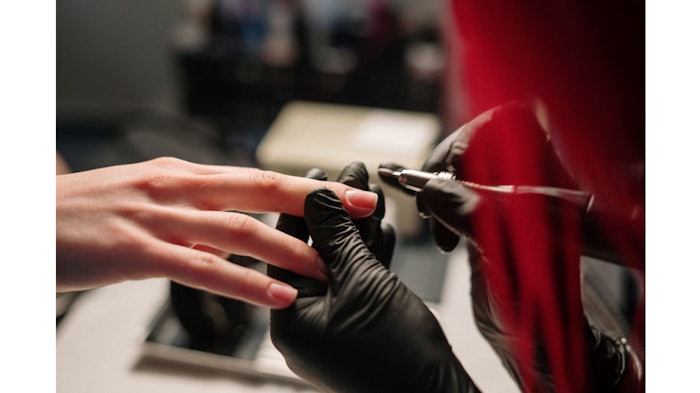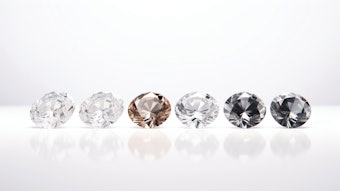
Liquid and powder enhancements (earlier known as acrylics in the 1970s and 1980s) became popular in the 70s and originally included the use of clear dental polymers to sculpt artificial nails on a form to lengthen and transform the look of the nail. The polymer was not specifically designed for use on nails in the salon. It was rather a methyl methacrylate-based material designed for crowns/caps for teeth made in a laboratory with powerful ventilation systems.
When nail pros tried to utilize this same material to create nail enhancements in a salon, the FDA warned against the vapors being inhaled by the pro and their clients without powerful ventilation. The substance was also deemed too hard for the natural nails, with no resiliency under impact. At that time, early versions of single-link polymers were available for nail enhancements but were inherently weak, required thickness for strength, yellowed when exposed to sun light and did not look natural.
Then, in 1979, the first-ever, revolutionary, cross-linked resin technology was developed, receiving several patents for the category. It turns out cross-linking the molecular chains made the nail enhancement tough, thin, nonyellowing and natural looking. Over four decades of continued development has taken this science to all new levels and has propelled L&P acrylic nails into the fastest growing segment today!
How L & P Works
The scientific term for liquid is monomer. The sculpting monomer is the “bonding agent” in the system. It contributes to cohesion with the powder, adhesion to the natural nail and controls levels of shrinkage during curing.
The scientific term for powder is polymer. The sculpting polymer is the “binding agent” in the system. It activates the cross-linking and polymerization of the liquid and determines the color and coverage levels of the enhancement.
Opaque powders help create an illusion of a sleeker nail by blocking out the natural nail’s smile-line with a camouflaging skin-toned color blend. Semi-sheer powders give a light overlay which can brighten the look of the nail bed underneath the coating. Lastly, sheer powders act as a reinforcing lens to allow the natural nail bed tone to come through. The nail professional will determine the best choice for the client during the service consultation.
Liquid and powder creates dramatic, designable and indestructible enhancements and provides control like no other system. It creates instant shape and length for clients who need transformation and ultimate nail protection. The pro will build the liquid and powder acrylic in beads to create the best arch placements and apex of the desired design. It takes around two to three minutes to set before it is ready to be filed and refined. Then, in 24 to 48 hours, the coating is fully cured and ready for wear until it is time for a rebalance. Once cured, it is recommended that the client use a lightweight oil daily to keep the coating resilient and tough.
The enhancement is a semi-permanent, durable service option for clients with soft and pliable nails. Clients should commit to a regular schedule of two-to-three-week rebalances to keep nails protected and the length/shape consistent.
Liquid and powder enhancement services can also be offered as a natural nail overlay, sculpted on a tip or on a form, and come in a wide range of colors, from every shade of neutral as well as bold primary, secondary and tertiary colors. The wide range of color allows for simple full coverage overlays or dramatic 3D sculpting, depending on need and desire.
Compatibly formulated liquids and powders must be used together as a system for optimum performance. When mixed, they form a putty-like consistency that can be molded and sculpted into shape on the natural nail and create length over a tip or on a form. As the mixture cures, it forms a highly protective solid material that bonds with the nail plate and grows out with the nail.
Universal Truths of Monomer and Polymer Systems
Monomer and polymer systems work best when:
- Used as a system with the proper mix ratio,
- Used at comfortable room temperatures (70–75˚F),
- Sculpted with the brush, not the file, and built with one to three beads for each nail,
- Finished with a fine 180/240 hand file or e-file, using a light touch,
- The natural nail is properly prepared prior to application,
- Skin contact is avoided during application,
- The working environment is clean and dust free,
- Fresh monomer is used for each client, and
- The enhancement is plasticized daily with a lightweight blend of oils, such as jojoba oil and vitamin E.
Problems can occur with monomer and polymer systems when:
- Using an improper mix ratio,
- Finishing with a coarse file and/or a heavy touch,
- Using liquid without powder,
- Adding set boosters to monomer,
- Using contaminated or outdated products, and
- Natural nail plate damage occurs from improper application or removal of enhancement product.
Liquid and powder acrylic nail enhancements are the best solution for problematic nails requiring dramatic transformation and ultimate protection. If the pro is educated on the best practices and takes the time to refine their skills, they will become a master of this wonderful medium.
About the Author
Jan Arnold is the co-founder and style director of CND. She is also a member of Nailpro’s 2022 advisory board.














